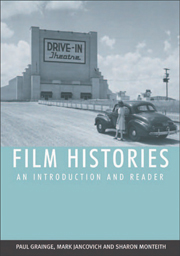Book contents
- Frontmatter
- Contents
- Preface
- Part I Film History from its Origins to 1945
- 1 The Emergence of Cinema
- 2 Organising Early Film Audiences
- 3 Nationalism, Trade and Market Domination
- 4 Establishing Classical Norms
- 5 The Age of the Dream Palace and the Rise of the Star System
- 6 Competing with Hollywood: National Film Industries outside Hollywood
- 7 The Rise of the Studios and the Coming of Sound
- 8 Realism, Nationalism and ‘Film Culture’
- 9 Adjustment, Depression and Regulation
- 10 Totalitarianism, Dictatorship and Propaganda
- 11 The Common People, Historical Drama and Preparations for War
- 12 Wartime, Unity and Alienation
- Part II Film History from 1946 to the Present
- Bibliography
- Copyright Acknowledgements
- Index
2 - Organising Early Film Audiences
from Part I - Film History from its Origins to 1945
Published online by Cambridge University Press: 05 August 2013
- Frontmatter
- Contents
- Preface
- Part I Film History from its Origins to 1945
- 1 The Emergence of Cinema
- 2 Organising Early Film Audiences
- 3 Nationalism, Trade and Market Domination
- 4 Establishing Classical Norms
- 5 The Age of the Dream Palace and the Rise of the Star System
- 6 Competing with Hollywood: National Film Industries outside Hollywood
- 7 The Rise of the Studios and the Coming of Sound
- 8 Realism, Nationalism and ‘Film Culture’
- 9 Adjustment, Depression and Regulation
- 10 Totalitarianism, Dictatorship and Propaganda
- 11 The Common People, Historical Drama and Preparations for War
- 12 Wartime, Unity and Alienation
- Part II Film History from 1946 to the Present
- Bibliography
- Copyright Acknowledgements
- Index
Summary
The enthusiasm that greeted story films in the early 1900s led many studios to shift decisively towards this type of film in meeting popular demand. The five main American production companies – Edison, Biograph, Lubin, Selig and Vitagraph – all moved into fiction filmmaking, as did the major film studios of Europe. From 1905 to 1906, this included the French studios Pathé and Gaumont, the Danish production company Nordisk, as well as the principal film companies of Britain and Italy such as Hepworth and Cines.
If cinema began to flourish in the 1900s, creating a soaring demand for new product, it was linked significantly to the rise of film exchanges. These first emerged in 1903 and had a profound effect on distribution and exhibition practices. Film exchanges enabled film producers to rent rather than sell their films. This had revolutionary implications. On the one hand, film exchanges helped to standardise film and turn it into an interchangeable commodity. On the other hand, they helped decouple the industrial arms of distribution and exhibition. These features would soon become central elements in the organisational structure of the wider film industry. Chicago became the largest centre of film exchanges in the mid-1900s, fifteen of the city's exchanges controlling 80 per cent of the rental business in the United States. These provided new prints to those exhibitors willing to pay a weekly premium.
- Type
- Chapter
- Information
- Film HistoriesAn Introduction and Reader, pp. 21 - 44Publisher: Edinburgh University PressPrint publication year: 2007



